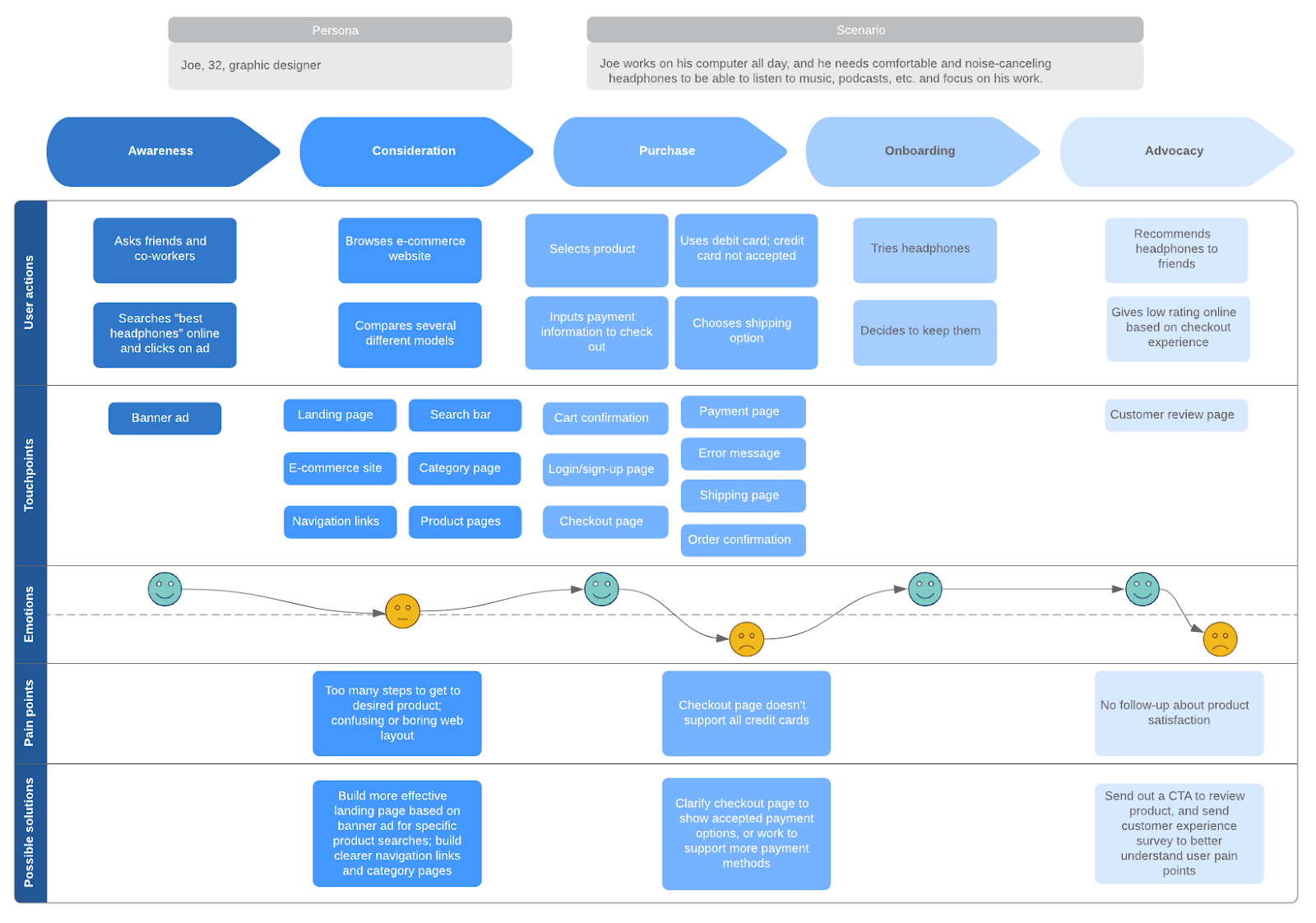- What is customer journey management?
- Processes of customer journey management
- What factors influence customer journey management
- How to build a customer journey management framework: 5 Steps
- Best practices of customer journey management
- Latest trends in customer journey management
- Common mistakes with customer journey management
The modern customer moves from touchpoint to touchpoint, expecting brands to remember their back story, needs and preferences throughout their journey. Customer journey management enables brands to understand each customer’s path toward conversion and beyond, and orchestrate journeys that are worth remembering and recommending.
While most modern brands apply efforts to map customer journeys, not many are able to logically interconnect customer touchpoints on the map, forecast the customer’s next move and proactively pivot to keep at-risk customers in the funnel. All of this comes within reach with relentless customer journey mapping.
This blog covers the basics of customer journey management – its definition, goals, implementation, best practices and common errors. Let's get started.
What is customer journey management?
Customer journey management is the strategic process of elevating the overall experience a customer has with a brand at all touchpoints in their customer journey. This process involves a couple of sequential sub-processes, including:
Customer journey mapping
Customer journey orchestration
Customer journey analytics
The journey facilitator plays a crucial role in the entire process, managing and measuring the experience at diverse touchpoints within a journey and recommending necessary adjustments to minimize friction and churn.
Customer journey management revolves around crafting an outstanding customer experience at each touchpoint and adopting a comprehensive approach to ensure customer satisfaction (CSAT).
Processes of customer journey management
Customer journey management is the sum total of many inter-connected parts and processes that culminate in enhanced customer experience and business growth. Here are the processes:
1. Mapping the customer journey
Mapping the customer journey involves visualizing and understanding each step a customer takes from the initial contact with the brand to post-purchase engagement. This process helps businesses identify pain points and opportunities for improvement.
With a visual, state-of-the-art journey builder, business leaders can create unified, omnichannel customer journey maps, representing the touchpoints your brand uses to communicate with customers across different channels. Here is an example:

2. Orchestrating unified customer journeys
Orchestration involves coordinating various touchpoints and channels to create a seamless and cohesive customer experience. It ensures that each interaction aligns with the overall customer journey strategy.
Designing the customer journey involves creating intentional and engaging experiences on digital and physical mediums.
Explore the Essentials: What Is Customer Experience Management?
3. Analyzing the customer journey experience
Next, customer journey analytics enters the picture, collecting and analyzing data related to customer interactions. By leveraging analytics tools, businesses can gain actionable insights into customer behavior, preferences and pain points.
Gaining consumer insights from raw behavioral data helps uncover customer motivations, preferences and the factors influencing their decision-making process.
What factors influence customer journey management
The customer journey is influenced by various factors that shape and impact the overall experience, including:
1. Pricing strategy
Beyond the apparent monetary value, consumers assess the perceived worth of a purchase. Factors such as discounts, promotions and perceived value contribute to the overall perception of a brand's pricing strategy. A competitive pricing model can attract price-conscious consumers, while premium pricing may appeal to those associating cost with quality.
2. Quality
The intrinsic quality of a product or service is an enduring factor that underpins customer satisfaction and loyalty. Beyond marketing messages, the actual performance, durability and reliability of a product contribute significantly to customer perceptions. Consistent quality builds trust, fosters positive reviews and encourages repeat business.
Also Read: From Average to Awesome — 3 Secrets of Efficient and Quality Customer Service
3. Convenience
Convenience has emerged as a cornerstone of modern consumer expectations. From user-friendly online interfaces to hassle-free return policies, businesses that prioritize convenience at every touchpoint stand to gain a competitive advantage. This extends beyond the purchasing process to encompass the start-to-finish experience, team responsiveness and overall ease of interaction.
Watch on Demand: Does Your Organization Meet the Expectations of Modern Customers?
4. Quality of customer support
Exceptional customer service builds stickiness and prevents customer churn. The post-sales phase is critical from a support standpoint, and businesses that deliver responsive and prompt support build customer loyalty. Customer service is not merely a transactional aspect but a relationship-building tool that can turn customers into brand advocates.
5. Corporate social responsibility
In an era where consumers are increasingly conscious of corporate values, social responsibility has become a significant influence on the customer journey. Businesses engaged in ethical practices, environmental sustainability and community support resonate with socially conscious consumers. Brands that actively communicate and demonstrate their commitment to social responsibility stand to build a positive and enduring reputation.
How to build a customer journey management framework: 5 Steps
A customer journey management framework is a structured approach that helps businesses understand and optimize their interactions with customers. This framework typically involves several steps like:
Step 1: Identify customer segments
The first step in creating a journey framework is to identify and understand different customer segments. This involves analyzing demographics, behaviors and preferences to tailor the customer journey to specific audience needs.
Step 2: Perform customer journey mapping
Mapping the customer journey is a visual representation of every interaction a customer has with a brand. This includes touchpoints across various channels - digital, voice and traditional.
Read More: Top 8 Customer Service Channels to Know About
Step 3: Collect customer feedback
Actively seeking and collecting customer feedback is crucial for evaluating experiences without subjectivity. Feedback can be gathered through customer surveys, reviews and direct interactions, providing valuable insights for improvement.
Step 4: Analyze and optimize
Once data is collected, businesses can analyze customer interactions to identify pain points and areas for improvement. Optimization involves refining strategies and making adjustments to enhance the overall customer experience.
Also Read: Customer Service Analytics – A Comprehensive Guide
Step 5: Implement and monitor
After optimizing the customer journey, it's essential to implement changes and monitor results rigorously. Regular monitoring ensures the customer journey remains aligned with business goals and adapts to evolving customer expectations.
Best practices of customer journey management
For the efficient implementation of customer journey management, it pays to adhere to certain best practices, such as:
1. Determine the right success metrics
To manage the customer journey effectively, it is essential to establish and monitor success metrics for customer experience. These metrics serve as quantitative indicators of how well the customer journey aligns with business objectives. Metrics may include customer satisfaction scores, Net Promoter Scores (NPS) and customer retention rates. By regularly measuring and analyzing these metrics, organizations gain actionable insights into the efficacy of their customer journey strategies.
Interesting Read: Average Customer Retention Rates by Industry
2. Leverage journey scores
Journey Scores, a nuanced approach to evaluating the customer experience at various touchpoints, offer a more holistic perspective than standalone CX metrics. By assigning scores to different stages of the customer journey, organizations can pinpoint areas of excellence and identify potential pain points. This granular assessment enables targeted improvements, ensuring a seamless and satisfying customer experience from awareness to post-purchase interactions.
Also Read: Customer Experience Mapping: Definition & Strategy
3. Maintain momentum
Continuous optimization is the heartbeat of successful customer journey management. Organizations must embrace an iterative approach, refining and adapting strategies based on real-time customer feedback, emerging trends and evolving business goals. This optimization process involves leveraging data analytics, customer feedback loops and market research to fine-tune touchpoints, streamline processes and enhance overall customer satisfaction.
Latest trends in customer journey management
Staying abreast of the latest CX trends is essential for businesses aiming to remain competitive in the dynamic landscape of customer experience management. Here are advancements to look out for in the coming years:
AI will be used to address staffing shortages
Artificial Intelligence (AI) is increasingly employed to enhance customer service, especially in addressing staffing challenges. AI-powered chatbots, virtual assistants and automated responses are not only helping companies manage increased customer queries but also providing quick and efficient solutions ensuring a seamless customer journey even during peak times.
Learn More: All About AI in Customer Service
There will be continued investment in customer loyalty
Recognizing the cost-effectiveness of customer retention over customer acquisition, businesses are making sustained investments in customer loyalty programs. These initiatives go beyond traditional point systems, incorporating personalized rewards, exclusive offers and engaging experiences to foster long-term customer loyalty.
Hyper-personalized experiences will rule the roost
The demand for hyper-personalization is driving the customization of customer experiences at an unprecedented level. Through advanced algorithms and machine learning, businesses can deliver tailored content, product recommendations and communication strategies, ensuring that each interaction resonates with individual preferences and behaviors.
Lines between physical and digital experiences will blur
The convergence of physical and digital realms is reshaping the customer journey. Businesses are integrating online and offline touchpoints seamlessly, providing customers with a cohesive experience. This trend involves technologies like augmented reality, IoT devices and innovative in-store digital experiences to bridge the gap between the physical and digital worlds.
Interesting Read: The Very “Undigital” Truth About Digital Transformation
Common mistakes with customer journey management
Despite the benefits of customer journey management, businesses often make common mistakes that can hinder the effectiveness of their strategies. Some of them are -
Fail #1: Not mapping the customer journey
One of the most significant mistakes is neglecting to map the customer journey comprehensively. Without a clear understanding of the customer's interactions, businesses may miss critical touchpoints.
Fail #2: Not involving stakeholders
Effective customer journey management requires collaboration across departments. Failing to involve key stakeholders, including marketing, sales and customer service teams, can result in a disjointed customer experience.
Fail #3: Neglecting impact evaluation
Measuring the impact of customer journey management strategies is essential for continuous improvement. Failing to track key performance indicators and analyze the results can hinder the ability to refine the customer journey effectively.
Fail #4: Ignoring real-time feedback
Customer feedback is a valuable resource for improvement. Ignoring or dismissing customer input can lead to missed opportunities for enhancing the customer experience.
Fail #5: Misalignment with the executive team
Successful implementation of customer journey management requires support from leadership and throughout the organization. Without a commitment to customer-centric strategies, the effectiveness may be limited.
Watch on Demand: The Re-Imagined Digital Customer Journey
Final thoughts
Customer journey management is a dynamic and essential aspect of modern customer retention strategies. As the business landscape continues to evolve, embracing customer journey management remains a strategic imperative for organizations aiming to deliver exceptional customer experiences.
As we wrap up this guide, it's crucial to highlight Sprinklr Service as a leading solution in this space. With Sprinklr Service, businesses can harness the power of cutting-edge technology to collect, analyze and leverage customer data effectively. In addition to supporting continued investment in customer loyalty, it prioritizes data privacy and continuous reporting.
Consider Sprinklr Service as a strategic ally to proactively shape and enhance your customer journey. Request a demo of Sprinklr Service to understand how it can assist you with unified customer journey management.
Frequently Asked Questions
Thank you for contacting us.
A Sprinklr representative will be in touch with you shortly.
Contact us today, and we'll create a customized proposal that addresses your unique business needs.
Request a Demo
Welcome Back,
No need to fill out any forms — you're all set.



